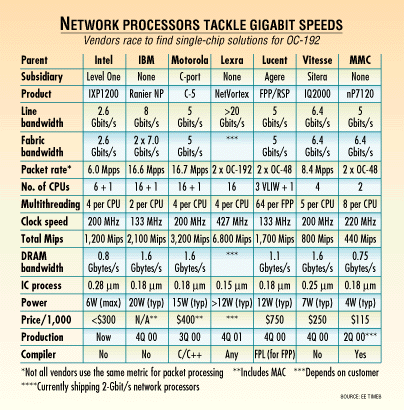

 |
Net processor makers race toward 10-Gbit/s goal
By Linley
Gwennap
EE Times
(06/19/00, 11:09 a.m.
EST)
The winners in the race to deploy a cost-effective single-chip design
for OC-192 must navigate IC process transitions, add more RISC engines and
replumb for higher bandwidth all around. These 10-Gbit/s chips will
probably require a shift to Rambus memory as well.
MMC Networks Inc. (Sunnyvale, Calif.), which originated the network
processor market, opened the jousting by laying out a road map to a
20-Gbit/s chip (full-duplex OC-192) slated for late 2001. MMC is even
claiming that other vendors will have problems scaling their architectures
to match that performance level.
That company, along with Intel, Sitera (now part of Vitesse) and Agere
(now part of Lucent Technologies), appears to have the most headroom in
its current designs. All four should be able to deliver OC-192 network
processors by the end of next year if they can execute well.
New entrant Lexra Inc. (Waltham, Mass.) also plans to ship an OC-192
network processor in late 2001. Meanwhile, IBM and C-Port — now a
subsidiary of Motorola — have more design work to do before deploying
single-chip OC-192 products.
The easiest way for network processor vendors to increase their
performance is to add more RISC engines. The task of processing packets is
inherently parallel, making it easy to share among many processor cores.
Each core can work on a different packet, and in a high-speed router,
there are plenty of packets to go around.
Adding cores is fairly easy. They are physically quite small, typically
just a few square millimeters in a 0.18-micron CMOS process. At that size,
vendors can pack 16 or more onto a modest-size die. Since all the cores on
a particular chip are generally identical, adding more requires little
design effort, although the bandwidth of the on-chip buses must be
increased accordingly. Connecting more than a handful of cores generally
requires an internal crossbar or switch rather than a single bus.
Adding engine muscle From that perspective, Intel, Vitesse and MMC will have an easier time
increasing their performance, since they use relatively few RISC engines
now. For example, Intel's IXP1200 is built in an aging 0.28-micron fab
acquired from Digital Equipment Corp. By moving the part to its
0.18-micron process, Intel could easily pack 16 RISC engines onto the die
while maintaining the same cost structure as the current six-cylinder
part.
Simply shoveling in more cores is good only to a point. IBM and C-Port
already pack 16 RISC engines into their high-end network processors.
Scaling much beyond that level stretches the bounds of an 0.18-micron
process. Furthermore, with 16 or more cores, just connecting the cores
consumes a significant part of the die area.
An alternative is to increase the clock speed of the RISC engines. A
faster clock allows each core to handle more packets, keeping the number
of cores in the processor to a more manageable level. It also reduces the
latency of each packet through the processor. For those reasons, network
processor vendors are looking to crank up their clock speeds.
For vendors using older IC processes, the solution can be as easy as a
process shrink. For example, Intel should be able to push the IXP1200 from
200 to 400 MHz by moving to 0.18 micron. Vitesse Semiconductor Corp.
(Camarillo, Calif.) should be able to match that speed by moving its Prism
IQ2000 device to a 0.15-micron process.
Agere Inc. (Austin, Texas) believes it has plenty of headroom in its
two-chip solution, comprised of a fast pattern processor (FPP) and a
router switch processor (RSP). The initial products, due to ship this
year, use a standard-cell design with a 133-MHz target clock speed. A more
customized design in an 0.18-micron process could see a 50 percent
speedup.
Lexra is already pushing the speedometer: At last week's Embedded
Processor Forum, the company disclosed that its NetVortex
processor will reach 427 MHz in a 0.15-micron process. The company is
confident of achieving OC-192 performance at this speed.
In addition to the 10 Gbits/s of line bandwidth needed for an OC-192
port, a network processor must have adequate bandwidth in other areas as
well. In general, the bandwidth to the switch fabric should match or
exceed the line bandwidth, since nearly all the traffic from one port will
be routed to another port.
IBM, Vitesse and MMC supply switch-fabric chips for their net
processors. MMC has already announced plans for a 320-Gbit/s switch-fabric
chip that will support several OC-192 lines in a single chassis. C-Port
claims compatibility with a variety of third-party switch fabrics,
including those from IBM and PowerX. To simplify this effort, the Common Switch Interface (CSIX) consortium
is developing a standard switch-fabric interface. Vitesse/Sitera, IBM, MMC
and C-Port are all CSIX members.
Memory requirements Memory bandwidth must also scale, as more packet data must be moved
into and out of DRAM. As a rule, a network processor memory subsystem
should be able to sustain at least twice the packet bandwidth, since most
packets will be stored into a DRAM queue and read back later. To allow for
other DRAM accesses and for the inefficiencies of synchronous DRAM,
current network processors have three to four times as much peak DRAM
bandwidth as packet bandwidth.
By this rule of thumb, a full-duplex OC-192 processor should sustain at
least 5 Gbytes/s (40 Gbits/s) to DRAM. Because double-data-rate SDRAM is
less efficient than standard SDRAM, even a 256-bit-wide DDR memory at 266
MHz would not reach this level. Not only would such a wide interface
require more than 500 pins, it would be difficult to support less than 256
Mbits using standard dual in-line memory modules.
Thus, most OC-192 processors are likely to move to Rambus. Four 800-MHz
RDRAM channels can sustain 5 Gbytes/s using only about 200 pins, making it
possible to use as little as 64 Mbits of memory. Other emerging DRAM
technologies, such as FCRAM, may also be used.
In this regard, Vitesse is ahead of the game by integrating an RDRAM
controller on its IQ2000. Most other devices are using PC100 SDRAM to
reduce cost, while IBM's Rainier net processor supports 200-MHz DDR SDRAM.
These other vendors will have to spend more design time integrating RDRAM
in their future devices, although IBM appears willing to accept the larger
pin counts required by SDRAM.
Putting it together MMC will deliver a multichip OC-192 solution by mid-2001, followed by a
single-chip design in late 2001, said director of marketing Robin Melnick.
These chips will use the same RISC engines as the recently announced
nP7120, MMC's third-generation net processor. The single-chip product will
use six RISC engines, three times as many as the nP7120. To meet the
processing requirements for OC-192, MMC will also boost the clock speed to
about 300 MHz by converting from a semicustom layout to a more optimized
design.
Intel will not comment on its plans, but its IXP device should make
OC-192 speeds by moving from its antiquated 0.28-micron process to the
0.18-micron process the company uses for its PC processors. In a
more-advanced process, a new IXP chip could contain 16 RISC engines
instead of six and run at 400 MHz or better. This second-generation device
is likely to appear by the second half of 2001.
Like the IXP1200, Vitesse's IQ2000 is designed for gigabit data
streams, and two Vitesse chips are required for full-duplex OC-48. With
only four RISC engines, the IQ2000 appears underpowered, but the chip is
able to match Intel's performance through better load balancing and a
more-efficient core design.
Stephen Sheafor, chief technology officer at Sitera Inc. (Longmont,
Colo.), said that Vitesse's next-generation design will leap from a modest
0.25-micron process to a leading-edge 0.15- or 0.13-micron process. With a
more-advanced process, the company could easily double the current clock
speed and move to 12 or 16 cores, reaching the performance needed for
OC-192.
For its part, IBM's Rainier was designed with OC-192 in mind, as it is
somewhat overengineered for OC-42 applications, according to chief
architect Chuck Sannipoli. For example, Rainier is designed for up to 8
Gbits/s of line bandwidth, well beyond what other network processors can
handle.
Shrink for speed But since Rainier is already in an 0.18-micron process, boosting the
clock speed or adding more RISC engines won't be easy. IBM is relying on a
shrink to 0.13-micron CMOS to boost the clock speed of the current device
to 200 MHz or so. To deliver a full-duplex OC-192 solution, the company
will pair two of these chips, one for upstream and one for downstream.
This approach, however, will put IBM at a cost disadvantage compared with
single-chip OC-192 solutions.
With 16 RISC engines, C-Port's C-5 has the most CPU power of today's
crop of net processors. The company expects clock-speed improvements in
the future, but extending the current architecture to full-duplex OC-192
would require 32 RISC engines at 400 MHz, which is not achievable even in
a 0.13-micron process.
Instead, C-Port is working on a new device, known as the C-Y, to reach
that level. Dave Husak, C-Port's chief technology officer, noted that
because the C-5 is programmed in a high-level language, it could use a
different microarchitecture while maintaining software compatibility
through recompilation. A more-powerful RISC engine would make a 20-Gbit/s
chip easier to build. Given the extent of the redesign, however, the C-Y
may not be available until 2002.
Agere believes its approach with the FPP/RSP chip set makes that
combination more easily scalable than competing devices. Instead of RISC
engines, Agere uses more-powerful specialized compute engines, each
handling a different task, and processes packets in a pipeline rather than
in parallel. Thus, Agere has left it to future products to exploit packet
parallelism.
Agere can reach OC-192 performance by simply setting up a second,
parallel packet pipeline and raising its clock speed to 266 MHz. That
speed should be achievable by a full-custom 0.18-micron version of the
current standard-cell 0.25-micron design.
For its part, Lexra is a relative latecomer to this market, but it
plans to deliver a 16-core version of its NetVortex processor by late
2001. At 427 MHz, this 0.15-micron chip will support full-duplex OC-192,
claims chief executive officer Charlie Cheng. Because Lexra is licensing
the core design, its licensees must grapple with the hard problems of
supporting enough memory and fabric bandwidth to handle two OC-192 data
streams.
Counting customers MMC already counts Cisco, 3Com and Nortel among its customers. As a
pioneer, MMC has had this market almost to itself, but competition is now
intense, and most other network processor vendors are now backed by large
semiconductor companies.
Intel is making a big thrust into networking, spending more than $2
billion to acquire Level One Communications and other network chip
companies. That figure doesn't even count the $625 million spent on
Digital Semiconductor, which supplied both the design and the fab for the
IXP1200. When Intel makes investments of this size, it expects a sizable
return.
The company claims to have 25 design wins for the IXP1200, including
Nortel, Ericsson and Newbridge. The part is not as sophisticated as some
of its competitors, but it is well-suited to gigabit data streams. With an
OC-192 part looking quite doable, Intel stands poised to carve out a big
chunk of this market.
IBM is the only major semiconductor vendor attacking the market with
homegrown technology. In fact, the company has already developed a low-end
chip, dubbed Charm, to complement Rainier, as well as a 28-Gbit/s
switch-fabric chip to connect up to eight of its network processors.
Most high-end networking products still use custom ASICs, and IBM is
the leading supplier of these ASICs. Thus, the company has already
established a channel for its network processors and switch fabric. This
broad product line has attracted several customers to Rainier, including
Nortel, Alcatel and Asante.
C-Port, meanwhile, is integrating its application programming
interfaces and development environment with its parent company's. Motorola
plans to deploy a single tool set to allow customers to write C or C++
programs that run on either C-Port processors or Motorola's standard
PowerPC and PowerQuicc devices.
This broad product line and reliance on high-level programming should
help the C-5 become widely used; the company already claims 20 design
wins, including three top-tier vendors. Because of the significant
redesign, however, C-Port's single-chip OC-192 solution is likely to
arrive later than those from other vendors.
Lexra's licensing strategy and ability to execute MIPS instructions
give it two significant differentiators. The largest network-equipment
vendors, such as Cisco and Nortel, are often hesitant to rely on a third
party to deliver a key component without a second source. They also don't
want to see other networking vendors using the same chips to deliver
similar products. Lexra allows licensees to design their own custom
components and select their own foundries, giving these giant vendors more
control over their own destiny.
By acquiring Sitera, meanwhile, Vitesse added a network processor to
its portfolio of physical-layer (PHY) chips and switch fabrics. But as a
sugar daddy, Vitesse is not as sweet as Intel, and it lacks the networking
ties of IBM and Motorola. Other than its Rambus interface, Vitesse's
IQ2000 has little to distinguish itself from the competition. The company
claims design wins at Quarry Technologies and Nortel, a promiscuous
networking vendor that seems to be on everyone's customer list.
Competitive crowd Now part of Lucent, Agere offers a solid OC-48 solution that should
scale well to OC-192. The FPP/RSP two-piece chip set, however, is more
expensive than any of the single-chip solutions. Agere claims the
requisite 20 design wins, but it remains to be seen whether Lucent has the
muscle to push Agere's product into a crowded marketplace.
By the end of this year, six vendors are slated to ship network
processors delivering 2-Gbit or better performance. By the end of next
year, several will be shipping 20-Gbit network processors. As more of
these devices become available, they will turn the tide away from the
hardwired ASICs that dominate high-end networking today.
"ASIC designers are always under fire from the software developers" who
need the hardware to validate their code, said Steve Fu, technology
partnership manager of Cisco Systems' enterprise router division. He
pointed out that programmable parts improve time-to-market by allowing
software to be tested earlier in the cycle.
Network-equipment makers evaluating the current processor choices
should first consider performance: Intel's IXP1200 and Vitesse's IQ2000
are best-suited for dual gigabit or single OC-48 streams, while the others
can handle dual OC-48 channels. If price is a concern, MMC is the leader,
whereas Agere's two-chip solution seems overpriced.
Another major criterion is whether to program in a high-level language,
which reduces development time, or in assembly code, which is more
compact. C-Port appears to have the best compiler today, while Lexra will
have strong tools support for its MIPS-based processors. Some may be
concerned that Intel is the only company in the industry that is not
supporting industry efforts, under the Common Processor Interface
consortium, to standardize APIs.
Many OEMs prefer to ensure compatibility by obtaining their components
from the same vendor. From this angle, IBM comes out on top. It has the
broadest line of network processors, switch fabrics, control processors
and (through its partnership with Multilink) PHY chips.
With several vendors in the processor market, networking companies have
a range of innovative products to choose from, and prices should be
reasonably low. No net processor vendor is likely to dominate. This
competition should spur increased adoption of network processors.
— Linley Gwennap is the founder and principal analyst of The Linley Group, a technology
analysis firm based in Mountain View, Calif.
|
|
| ||||

 |
| All material on this site Copyright © 2001 CMP Media LLC. All rights reserved. |
|
|

